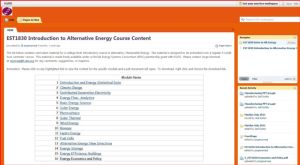Introduction to Alternative Energy: Course Content

Description:
FLATE, the Florida Advanced Technological Education Center for Manufacturing, has developed a collection of materials designed for use in a college-level introductory course in alternative and renewable energy. These 16 modules were developed in partnership with the Florida Energy Systems Consortium (FESC) and may be adapted to support middle, high school, and college curriculum, as well as professional development for STEM teachers.
Lesson Contents:
The alternative energy curriculum is composed of 16 modules, each of which includes detailed presentation slides. The course is divided five general sections across the 16 modules:
1. Introduction and Energy Statistical Data
1.1 Overview
- 1.1.1 Energy Definition and Units
- 1.1.2 US Energy Consumption Statistics
- 1.1.3 World Energy Consumption Statistics
- 1.1.4 Alternative and Renewable Energy Statistics
1.2 Climate Change
- 1.2.1 Fossil Fuel Perturbations
- 1.2.2 Climate Change Variables
- 1.2.3 Greenhouse Gases
- 1.2.4 Radiative Forcing
1.3 Centralized versus Distributed Electrical Generation
- 1.3.1 Centralized Power Generation
- 1.3.2 Electricity Demand Management
- 1.3.3 Decentralized Power Generation
- 1.3.4 Load Imbalance Mitigation
1.4 US Energy Flow Analytics
2. Basic Engineering Science for Energy
2.1 Forms of Energy
- 2.1.1 Motion Energy
- 2.1.2 Gravitation and Mechanical Energy
- 2.1.3 Electrical Energy
- 2.1.4 Radiant Energy
- 2.1.5 Thermal Energy
2.2 Thermodynamics
- 2.2.1 Thermodynamics- 1st Law
- 2.2.2 Thermodynamics- 2nd Law
2.3 Chemistry
- 2.3.1 Periodic Table
- 2.3.2 Stoichiometry
3. Energy Production
3.1 Renewable Energy Technologies
- 3.1.1 Solar Energy
- 3.1.2 Wind Energy
- 3.1.3 Biomass Energy
- 3.1.4 Hydro Energy
- 3.1.5 Fuel Cells
3.2 Alternative Energy: New Directions
- 3.2.1 Thermoacoustics
- 3.2.2 Thermoelectrics
- 3.2.3 Magnetocalorics
- 3.2.4 Sun Heat Thermochemical Storage
- 3.2.5 Liquid Metal Battery
- 3.2.6 Fusion
3.3 Energy Storage Challenges
4. Energy Efficiency
Why Energy Efficiency?
Building
Technologies
5. Economics and Policy
Below is a list of the files contained within the .zip attachment. The size of each file is included in parenthesis.
EST 1830 (16 files, 66.5 MB)
- Introduction and Energy Statistical Data (1_1_EST1830+Introduction+and+statistical+data.pdf 3.3MB)
- Climate Change (1_2_EST1830+Climate+Change.pdf 4.9MB)
- Distributed Generation Electricity (1_3_EST1830+DistGenElectricity.pdf 6MB)
- Energy Flow: Analytics (1_4_EST1830+Energy+Flow_Analytics.pdf 873 KB)
- Basic Energy Science (2_1_EST1830+Basic+Energy+Science_2.pdf 5MB)
- Solar Energy (3_1_1_0_EST1830+Solar_Sun+Energy.pdf 3.7MB)
- Photovoltaics (3_1_1_1_EST1830+Solar_Photovoltaics.pdf 3.3MB)
- Solar Thermal (3_1_1_2_EST1830+Solar+Thermal.pdf 6.1MB)
- Wind Energy (3_1_2_EST1830+Wind+Energy.pdf 5.8MB)
- Biomass (3_1_3_EST1830+Biomass+Energy.pdf 4.2MB)
- Hydro Energy (3_1_4_EST1830+Hydro+Energy_Tida_Wave.pdf 6.2MB)
- Fuel Cells (3_1_5_EST1830+Fuel+Cells.pdf 3.9MB)
- Alternative Energy: New Directions (3_2_EST1830+Alt+Energy_New+Directions.pdf 3.4MB)
- Energy Storage (3_3_EST1830+Energy+Storage+Challenges.pdf 2.4MB)
- Energy Efficiency: Buildings (4_1_EST1830+Efficiency.pdf 5.5MB)
- Energy Economics and Policy (5_EST1830+Economics+and+Policy.pdf 2.1MB)
About this Resource


Comments